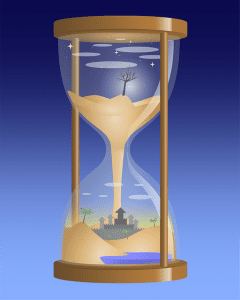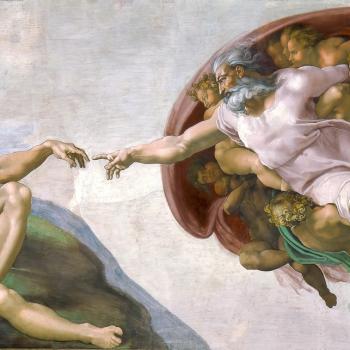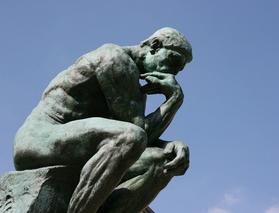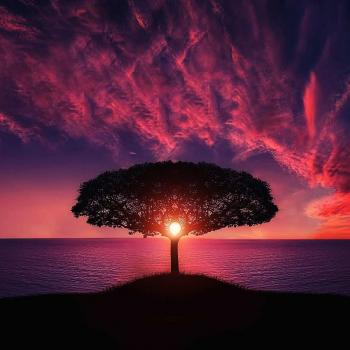
Life. For some of us, it is a vale of tears — an experience to be endured and grappled with as we look toward the eventual relief of death. For others, it is simply a biological process of gestation, birth, growth, flourishing, decline, and death. End of story. Still others hope to see it as a stepping-stone toward something more mysterious and grand — an unfolding, expansive process, leading to some idealized destination far in the future.
For most of our history, since humans began thinking beyond the next meal or the next predator, people have wondered about what lies “beyond”. While the sciences emerged to deal with the physically obvious (or at least what can be seen, measured, or inferred), philosophies and religions have pondered the non-obvious — in particular, what lies outside of mortal existence. Where did we come from? And to where do we go?
After a lifetime of growth, development, discovery, learning, and achievement, some are distressed by the notion that all of this largely passes into oblivion upon death. We’d like to believe that our efforts and existence counted for something — that it all “mattered” in some enduring way. Though perhaps naïve by the standards of the modern world, it is comforting to believe that the life-process is directed toward some sort of teleological goal or purpose.
From a secular perspective, one means to further the above goal is simply to extend the human lifespan. Accordingly, some are preoccupied with staying healthy and youthful by means of nutrition, exercise, and taking fistfuls of vitamins. Some even look toward replacing worn out body parts through transplants and stem cells. Others (like the poster-boy inventor and futurist Ray Kurzweil) even look forward to the ability to eventually replace the fallible biological body with an infinitely repairable cybernetic mind and body.
Far older than the above, religions have long looked toward the emergence of a transcendental realm wherein our mortal form is subsumed or eclipsed by something grander, something “divine” — a place or a condition in which we then would dwell forever.
Yet what would it mean to “live forever”, to exist “eternally”? Our life experience occurs in a world with three dimensions of space and one of time. Virtually everything we know and can conceive of is derived from our experiences in the physical world. (A simple example: we all know the colors of the visible light spectrum – red, orange, yellow, green, blue, indigo, violet. Yet what ‘colors’ lies beneath red or beyond violet? We can’t say, except to liken them to what we do know – hence “infrared” and “ultraviolet”.)
Moreover (and this may require some mental recalibration), colors do not actually exist in the world, apart from our brain’s perception of them. The “redness” of tomatoes and the “greenness” of grass is not an independent property of those objects. They simply reflect particular wavelengths of electromagnetic energy in the range that our eyes can perceive. Our brain, not being set up to measure light-wave nanometers, finds it more efficient to give us an experience of “red” or “green”.
Similarly, in regard to existence, we cannot imagine it happening except in the context of the linear passage of time. Accordingly we can pose questions that have the appearance of meaning yet actually are not meaningful outside of physical experience: What happened before the Big Bang? What happens after death?” Because the experience of linear time pervades everything we experience and can imagine, it is virtually impossible to conceive of anything happening outside the dimension of time.
Because of the above, we commonly think of “forever” and “eternal” as simply meaning a really, really, REALLY long time. However, it should more properly be thought of as “beyond time” or “all time” – an eternal “now”. Again, the analogy of the visible light spectrum: all colors taken together produce white light. Yet if every object reflected the full visible spectrum, navigating the world would be impossible as it would difficult to distinguish individual features.
So too with time. Astronomer John Wheeler once quipped that “Time exists to keep everything from happening all at once.” Though perhaps intended as a joke, I believe this points to something true (… and I caution that what follows will become more speculative).
We puzzle over the astrophysical theory that our unimaginably vast universe – billions of clusters of billions of galaxies – all emerged from a tiny dimensionless point – virtually nothing – in one “big bang”. Rather than a universe of everything-from-nothing, I find it more sensible that we live in a universe of something-filtered-from-a-grander-realm-of-everything — one possibility perceived out of a context of all possibilities.
Accordingly, just as color is necessary to distinguish and navigate features of the world, time – or more precisely change – is necessary for life as we know it to proceed. Max Planck (one of the founders of Quantum Physics) once observed that “It is impossible to measure the changes in things by time. Rather, time is an abstraction at which we arrive by the changes in things.” If this is the case, an eternal, unchanging realm would be one where nothing happens, because all is whole and complete. (Perhaps this is why gods and demons are so eager to possess people and muck with their lives!)
There is some mathematical justification for the notion of an all-time-encompassing eternity. We know time as the fourth dimension of our universe, along with the dimensions of space. Note that in Geometry, as one proceeds up the dimensional ladder, all lower dimensions become immediately perceivable from the standpoint of the next higher dimension. The first is a dimensionless ‘point’. Next is a one-dimensional ‘line’ – which is the summation of an infinity of points. Then comes the two-dimensional ‘plane’, which constitutes an infinity of lines. Above this is a ‘volume’ – all possible planes. ‘Time’ then is essentially the possible change-states of the volume.
What would the next higher dimension look like – the one that makes all moments in time concurrently available? We really cannot say, as such a condition is completely beyond normal experience. Interestingly though, the so-called “past lives” phenomenon may suggest a partial answer. I propose that past lives may not be “past” so much as parallel or “sideways” lives – a glimpse into a Schrödinger’s Cat-like paradox wherein multiple possibilities may be concurrently perceivable.
To know and have regular access to the above experience may seem appealing, however doing so might then make it difficult to remain as an embodied participant in the routine affairs of daily life. (Probably why you don’t see many gods and demons hanging out at Starbucks.)
Time Travel
For centuries, imaginative people have wondered about the possibility of time travel. “If I can remember and “see” the past in my mind, could I perhaps go there again in body?” Mainstream science also speculates about this possibility and the theoretical mechanisms by which it might occur.
Yet what would this mean in view of the cosmology set out above? Well, good news and bad. If Planck is correct that time is really just change, the conventional view seems to require winding the universe back to an earlier state — or pushing it forward to some deterministic future. I’m going to go out on a limb and suggest that would be challenging.
However, if time is a “user illusion”(1), imposed by consciousness upon a substrate of all-possibility so as to enable life to flow as a manageable sequence of events, then what we think of as past and future may co-exist, along with all other unrealized possible pasts and futures, in the Eternal Now. In other words, what we think of as past or future is actually co-present now. It is simply that it has fallen off the “radar screen” of perception in the case of the past, and has not yet reached the screen in the case of the future.
In principle, were our consciousness to be sufficiently expanded, perhaps some of these parallel times and realities would become perceptible. Perhaps that is what happens in some uncontrolled manner during drug experiences or in the REM sleep state.
Heaven, Nirvana, Etc.
If perception of the flow of time is necessary for living experience to occur, what would any hoped for ideal, eternal, “divine” destination be like? For all the impetus religions have given to human affairs, our visions of a Heaven are pretty insubstantial. Humorist Mark Twain once likened it to an eternal church service, “which as we all know, no man can abide for more than two hours”. Others think of it as an ability to indulge every whim ad nauseum, without consequence. Still others see it as an eternal stupor of bliss. For this we’ve gone to wars that through the ages have slaughtered millions?
However, if at the ultimate level, reality is a superposition of all possible states of being and all possible outcomes, and we at some point evolve or are granted willful agency to focus upon and realize particular times, places, and experiences, out of a virtual infinity of options, we might then have the ability to visit and enjoy an infinity of times, places and realities. At the least, it would make for a plethora of volunteering opportunities or one heck of a vacation!
(1) “User illusion” comes from a book of the same name by Tor Norretranders. It refers to a deliberate misperception that is adopted for convenience. For example, flipping bits and bytes in a computer to convey a message is tedious, so word processors provide us with the illusion of typing words on a sheet of paper.
















